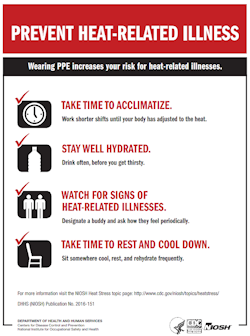Preventing Heat Stress
Workers wearing protective clothing, particularly in hot environments or within containment structures, can face a risk from heat stress if proper control measures are not used.
There are many factors that have a role in creating an occupational heat stress risk to workers. These factors include:
- environmental conditions (such as air temperature, humidity, sunlight, and air speed), especially on sequential days;
- presence of heat sources (e.g., hot tar ovens or furnaces) in the work area;
- level of physical activity, i.e., the workload leading to body heat production;
- use of clothing or protective gear that can reduce the body's ability to lose excess heat; and
- individual/personal risk factors.
Prevention Stratigies
- discuss the possibility of heat stress and its signs and symptoms with all workers;
- use appropriate work/rest regimens;
- provide heat stress monitoring that includes measuring employees' heart rates, body temperatures, and weight loss;
- choose lighter, less insulating protective clothing over heavier clothing, as long as it provides adequate protection; and
- drink electrolytes in a non-contaminated eating and drinking area close to the work area so employees can drink often throughout the day. Workers must wash their hands and face before drinking any fluid if their airborne exposure is above the PEL.
For more information on heat stress see Course 602, Heat and Cold Stress Safety and OSHA's Heat Stress Quick Card.
Knowledge Check Choose the best answer for the question.
2-7. Which of the following is a safe work practice that helps to prevent heat stress at work?
You forgot to answer the question!

